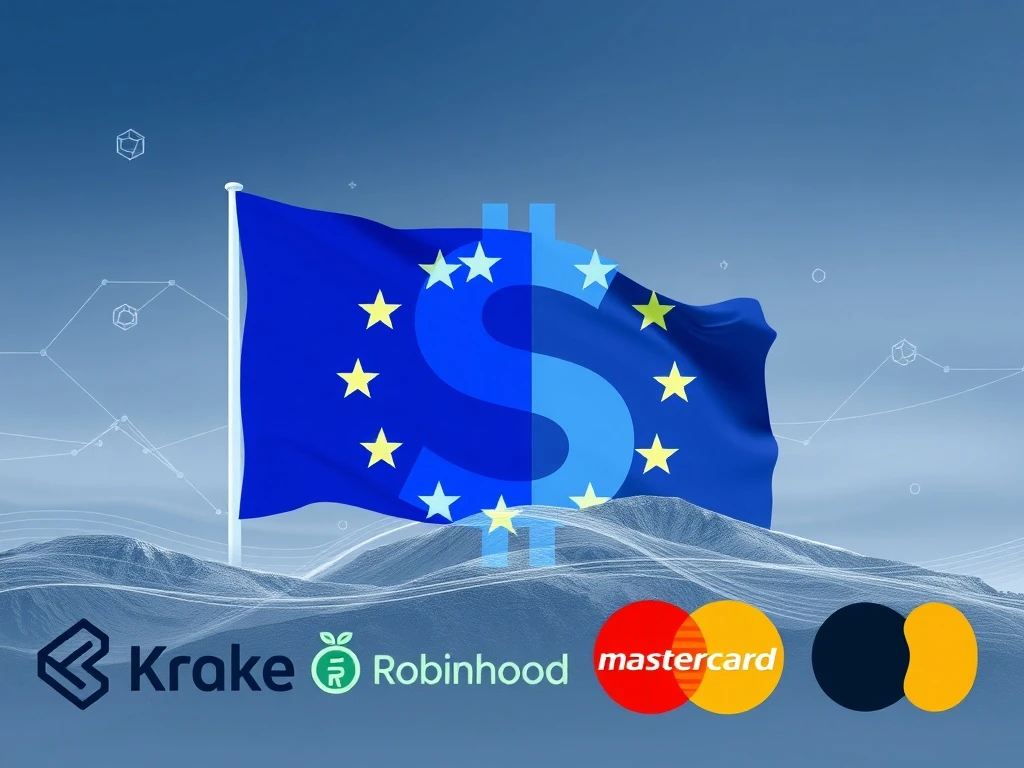Global Dollar Stablecoin: Unleashing Revolutionary MiCA Compliance in EU Crypto Markets

The cryptocurrency landscape is constantly evolving, with stablecoins emerging as a crucial bridge between traditional finance and the digital economy. A significant development is unfolding in Europe, where regulatory clarity is paving the way for wider adoption. The launch of the Global Dollar stablecoin in the European Union, backed by major players like Kraken and Robinhood, marks a pivotal moment. This move not only signifies growing institutional confidence but also sets a new standard for regulatory adherence in the region’s burgeoning crypto market.
The Rise of Global Dollar: A New Era for EU Crypto
The Global Dollar (USDG), issued by Paxos, has officially launched in the European Union. This stablecoin is designed to meet the stringent requirements of the Markets in Crypto-Assets Regulation (MiCA), a landmark regulatory framework. Paxos Issuance Europe OY, a Finland-based entity, oversees USDG in Europe, with supervision from the Finnish Financial Supervisory Authority and Singapore’s central bank. This multi-jurisdictional oversight aims to instill confidence and ensure stability for users across the continent. The arrival of USDG on platforms like Kraken and Gate signals its immediate accessibility for a broad user base, aiming to streamline digital transactions within the EU crypto ecosystem.
Key platforms now offering USDG include:
- Kraken
- Gate
- Coinmetro
- SwissBorg
- Zodia Custody
- Orbital
- Hercle
- CoinsPaid
- Bitwyrem
- Bitnet
- HiFi
Navigating MiCA Compliance: Why It Matters for Stablecoins
One of USDG’s most compelling features is its commitment to MiCA Compliance. The Markets in Crypto-Assets Regulation is Europe’s comprehensive framework for digital assets, setting standards for consumer protection, market integrity, and financial stability. Paxos states that USDG adheres to MiCA’s strict reserve and audit requirements, guaranteeing one-to-one redemption. A portion of its cash reserves will be held in European banks, further solidifying its regulated status. This level of regulatory alignment is critical for stablecoins seeking to become core infrastructure for global finance, offering transparency and reliability that traditional financial institutions demand.
Paxos Stablecoin: Building Trust and Infrastructure
As the issuer, the Paxos stablecoin, USDG, benefits from Paxos’s established reputation in the digital asset space. Walter Hessert, head of strategy at Paxos, highlights the “rapid ascent” of stablecoin demand, a trend supported by recent market data. According to RWA.xyz, the stablecoin market capitalization reached $239 billion in late June, rising to $253.85 billion at the time of writing, as per DeFiLlama. This growth reflects a belief among consumers and businesses that stablecoins can address significant financial pain points, from cross-border payments to efficient treasury management. Paxos aims to capitalize on this demand by providing a robust, compliant, and widely accessible stablecoin solution.
The growth trajectory of stablecoins is evident:
- Stablecoin market cap: From $239 billion (late June) to $253.85 billion (current).
- Interest in stablecoins: Tripled year-over-year since 2024 (Coinbase report).
- Total transactions: $94.2 billion settled between January 2023 and February 2025.
This data underscores stablecoins’ increasing role as a significant component of global payment infrastructure.
Kraken, Robinhood, and Beyond: Powering the Global Dollar Network
The expansion of USDG into Europe is part of a larger vision: the Global Dollar Network (GDN). This initiative represents a broad collaboration aimed at building foundational infrastructure for stablecoins. Key supporters of GDN include not only Kraken Robinhood but also Anchorage Digital, Worldpay, Galaxy Digital, and over 20 other financial and fintech companies. A significant endorsement came with Mastercard recently joining the GDN, signaling growing interest from traditional finance in leveraging stablecoin technology. Mark Greenberg of Kraken noted USDG’s “usability and growing ecosystem,” emphasizing its potential to become a core component of global finance. This collaborative approach, bringing together crypto-native firms and established financial giants, is crucial for fostering widespread adoption and integration of stablecoins into mainstream financial systems.
What Does This Mean for the Future of Digital Finance?
The launch of USDG in the EU, backed by a robust network and strong regulatory compliance, signifies a maturation of the stablecoin market. It moves stablecoins beyond speculative assets to practical tools for everyday financial transactions. The emphasis on MiCA compliance provides a blueprint for other stablecoin issuers looking to expand into regulated markets, fostering greater trust and stability. As more traditional finance players like Mastercard join initiatives such as the GDN, the lines between traditional and decentralized finance continue to blur, paving the way for a more integrated global financial ecosystem. The increasing circulation of yield-bearing stablecoins, now at $11 billion and 4.5% of the total market, further indicates the innovative applications emerging within this space, promising new opportunities for users to earn returns on their digital assets.
A Strategic Leap for Stablecoins
The introduction of the Global Dollar stablecoin in the European Union marks a strategic leap forward for the entire stablecoin industry. By prioritizing regulatory compliance through MiCA and securing backing from industry giants like Kraken, Robinhood, and Mastercard, Paxos is not just launching a product; it’s laying down critical infrastructure for the future of global finance. This development underscores the growing demand for stable, reliable digital currencies and their potential to address existing financial inefficiencies. As stablecoins continue to gain traction and regulatory clarity, their role in bridging traditional and decentralized financial systems will only expand, promising a more efficient, accessible, and interconnected global economy.








